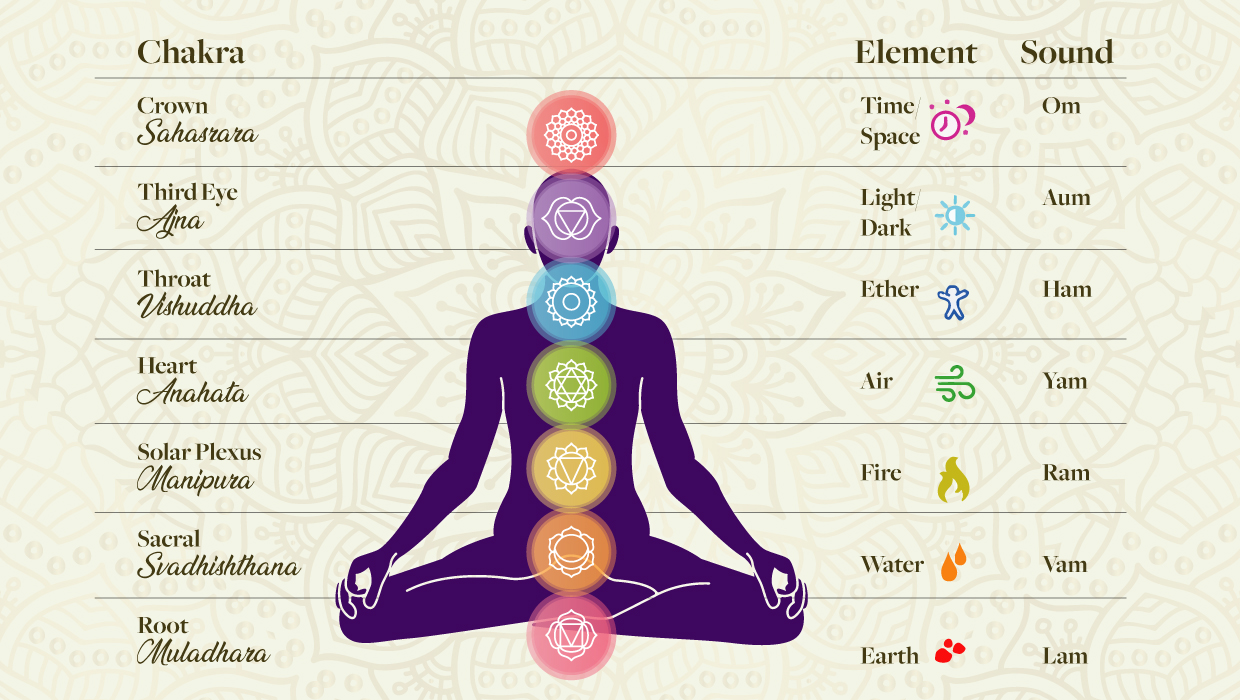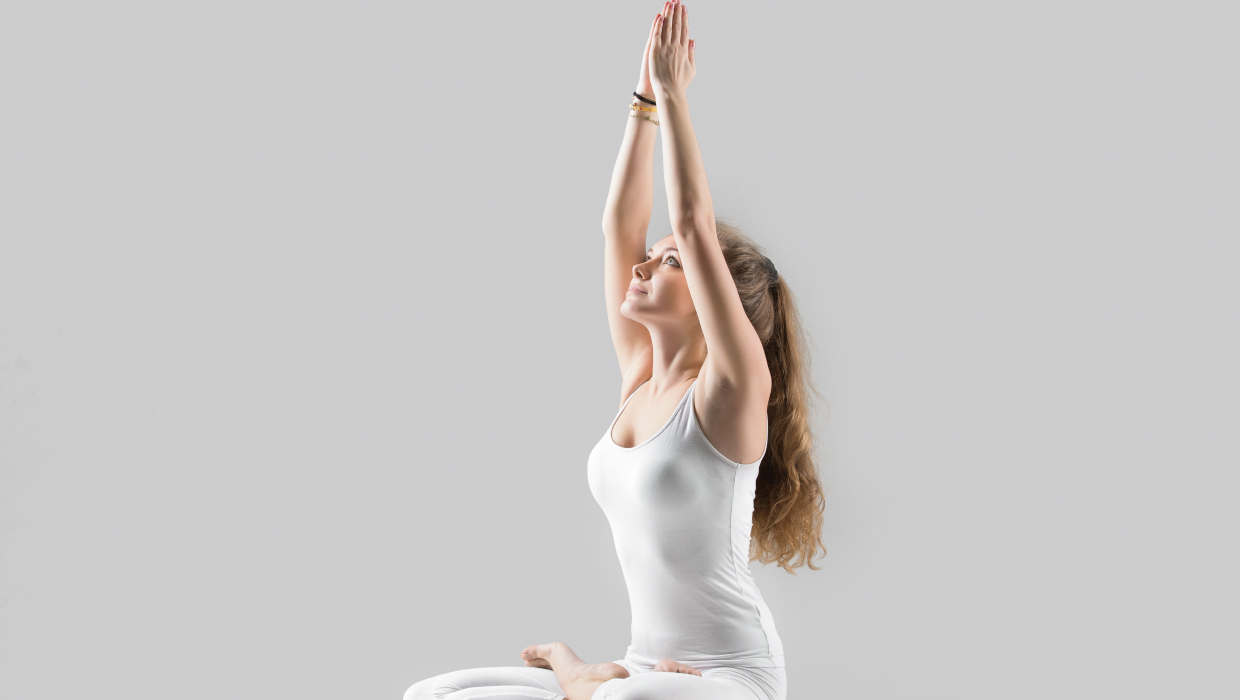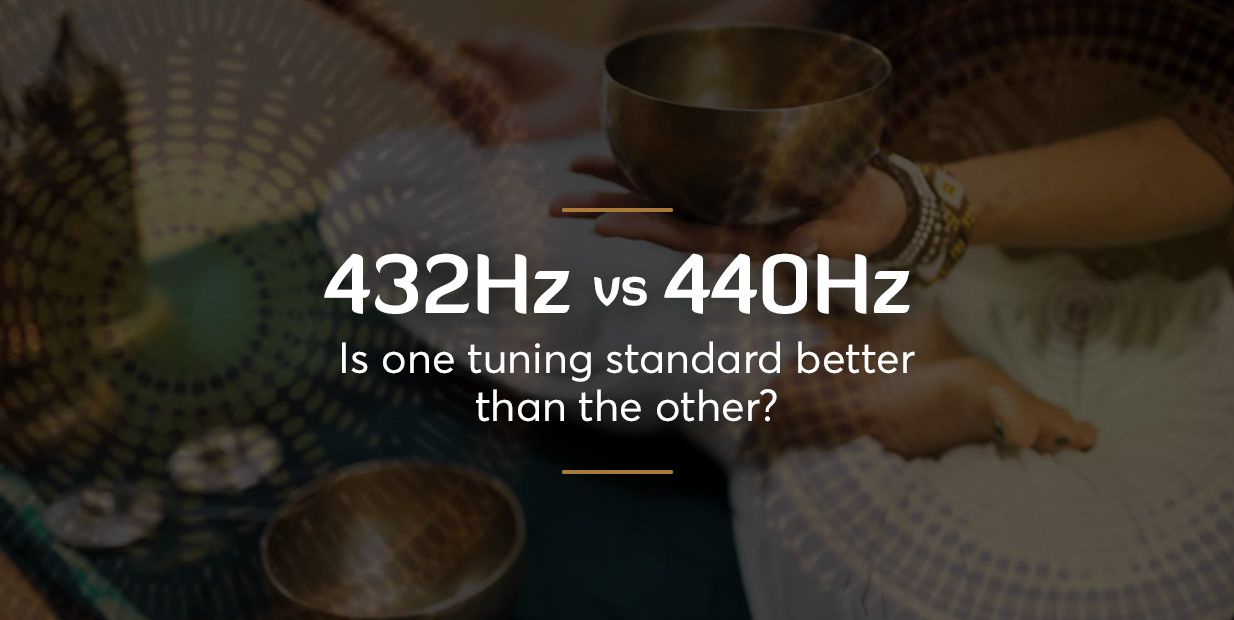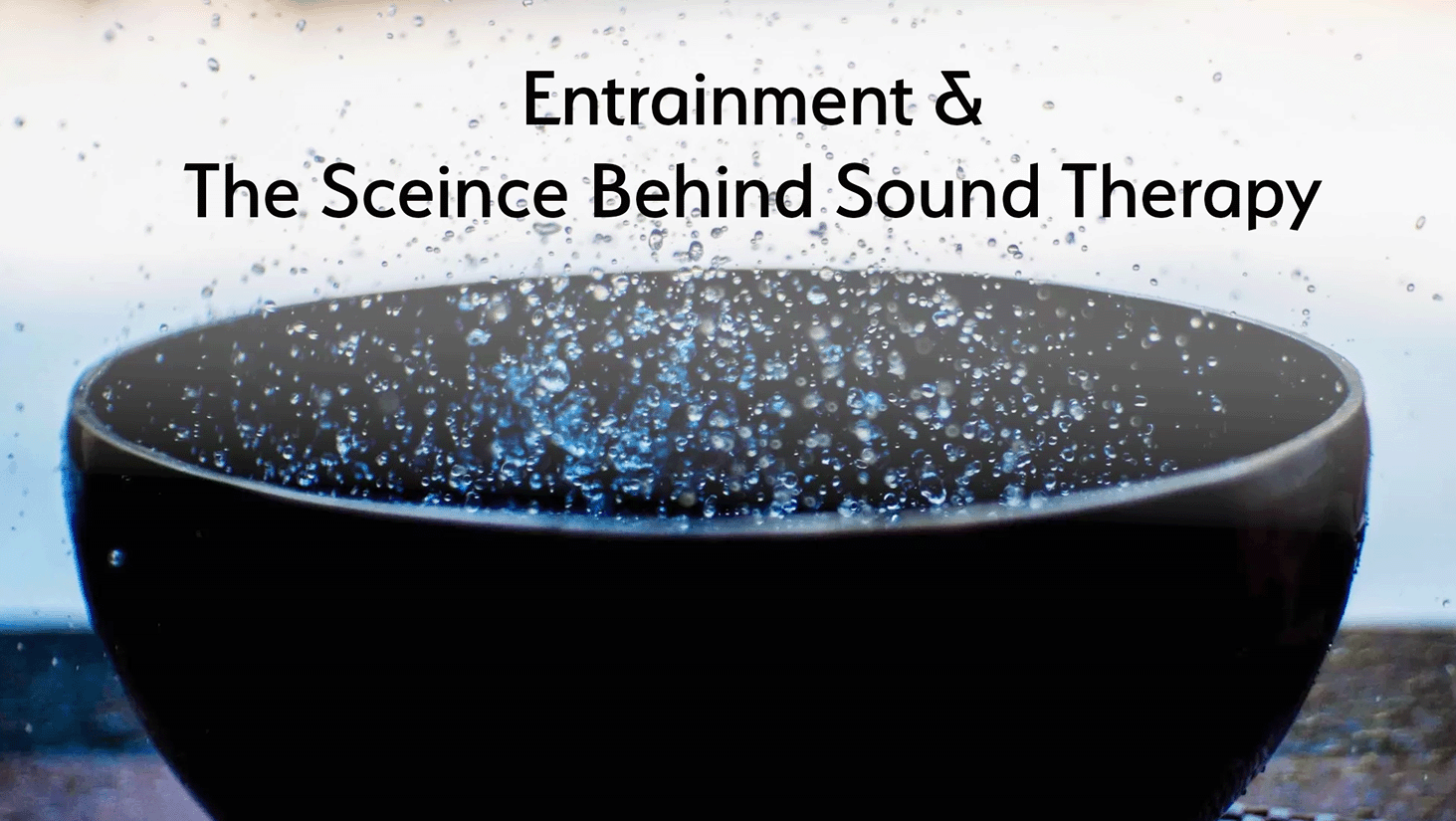According to yogic philosophy, Chakras are spinning energy centers located in the body where subtle energy channels, known as Nadis, intersect and flow. Chakra in Sanskrit means wheel or a circle. Chakras are a part of the subtle body and cannot be physically seen, but yogis believe that balancing the chakras is essential for mental and physical health.
The chakras are positioned in a straight line configuration starting from the base of the spine to the crown of the head. Each chakra has its vibrational frequency, which in turn is represented by a particular color, element, crystal, and the sound of Mantra as well as Asanas (Yoga Poses) to help open up the chakras when out of balance.
Although there are many energy centers located in the body, Yogis look at 7 main energy centers. Each chakra has a color, a mantra, and a symbol associated with it which may be used for meditating upon that chakra. Each chakra may also be visualized as a wheel with a fixed number of spokes, or a lotus with the same number of petals.
The goal of various yogic practices including Kundalini Yoga is to raise the primordial energy located in the base of the spine along the Nadis (energy channels) to the Sahasrara (crown) chakra and beyond.
Various alternate healing techniques such as Pranic healing, sound baths, and crystal healing focus on opening blocked chakras.
Blocked Chakras can result in emotional or physical illnesses.
This is similar to blocked pipes in a drainage system interrupting the flow of water throughout the house. Let’s take a closer look at the physical, mental, and emotional characteristics associated with each chakra in detail.

Muladhara (The Root Chakra)
Muladhara, translated as “root support”, is positioned at the base of the spine. Its main function is to look after the spine, legs, feet, as well as the physical body. This chakra provides everything one needs to survive and prosper such as food, water, stability, security, and physical vitality.
When the first chakra is balanced, one feels safe, secure, and fearless. When out of balance, one might feel afraid of life, withdraw from physical reality, feel victimized or feel drained out. One might also develop physical disturbances in the hip, feet, legs, or spine area.
Svadhisthana (The Sacral Chakra)
Svadhisthana, translated as “her own abode”, is positioned just below the naval. Its purpose is to look after the bladder, kidneys, reproductive system, and lower abdomen. This chakra deals with the emotional body, sensuality, and creativity.
It is the center of one’s feelings and emotions that are responsible for the sensorial pleasures of life. When out of balance, one might develop problems in the kidney, bladder, or pelvic area.
Manipura (Solar Plexus Chakra)
Manipura, translated as “city of jewels’ ‘, is positioned just above the naval. Its’ function is to make sure the stomach, liver, intestine, pancreas, gallbladder, and digestive system are working properly. It represents the center of the body; where food is assimilated, turned into energy, and distributed throughout the body. Its aim is to help one find direction in life and to take the actions needed to reach its goal. Therefore by not allowing people’s opinions and negative beliefs to influence one’s state of mind or decision making.
When out of balance, one might suffer from bad digestion, liver, and pancreas problems. One might also experience trouble standing up for one’s belief or self, the need to dominate others and develop insecurities related to financial matters.
Anahata ( Heart Chakra)
Anahata, translated as “unstruck”, is positioned in the middle of the chest. Its’ function is to look after the heart, lungs, thymus gland, liver, and circulatory system. This chakra keeps the heart open and loving, therefore making it easier to express emotions and become more compassionate towards people. The heart chakra acts as a purification system for all other chakras, thereby cleansing them of any negative emotions and allowing the energy field to remain positive.
When open, one can feel a deep sense of connectedness with everything and realize that there is beauty all around. Empathy, forgiveness, and love for oneself is another benefit of having the heart chakra activated. However, when out of balance, one may experience difficulties in relationships with others, inability to love, lack of sympathy, fear, anger, sadness, and disconnection. As well as, heart-related problems, lung infections, and bronchitis.
Vishuddha (The Throat Chakra)
Vishuddha, translated as “to purify”, is positioned in the center of the neck. Its’ function is to look after the throat, jaw area, thyroid gland, upper lungs, vocal cords, arms, and digestive tract. This chakra essentially helps to find one’s truly authentic and individual voice, and assists in expressing it. Therefore making it a key component of verbal communication. Behavioral and psychological characteristics associated with this chakra can include a good sense of timing, releasing one’s vocational purpose, and propensity to create and project ideas into reality.
When blocked, it can lead to a lack of control of one’s speech, speaking too much or inappropriately, may experience feelings of anger, hostility, and resentment, not being able to listen to others, excessive fear of public speaking, or telling lies. One may also experience respiratory disorders, dental disorders, and low self-esteem
Ajna (Third Eye chakra)
Ajna, translated as “the command center”, is positioned in the middle of the forehead, just above the eyebrows. Its’ function is to look after the lower brain, neurological system, left eye, ears, nose, and pituitary gland. This chakra can enable the self-healing process by heightening intuition and the sense of self.
It activates intuition, vision, perception, and movements of energy. It connects the individual to inner wisdom and can unlock one’s psychic abilities related to clairvoyance and clairaudience.
When imbalanced, it can result in a lack of clarity, feeling stuck, and unable to see past problems to solve them. Physical symptoms of imbalance or blockage in this chakra manifests as persistent headaches (especially in the center of the forehead), insomnia, anxiety, and depression.
Sahasrara (Crown Chakra)
Sahasrara translated as “thousand-petaled lotus” is located on the crown of the head. Its’ function is to look after the pineal glands, upper brain, the right eye, and nervous system. The crown chakra provides access to hightened states of awareness which is the primary aim of Yogic practices.
When out of balance, it will result in close-mindedness, disconnection with self and others, living in one’s head, and being detached from one’s body and earthly matters. It may also result in feeling lonely, fearing death, and comparing ourselves unfavorably to others. Physical symptoms of blockages may result in neurological disorders, nerve pain, and Alzheimer’s.
Balancing Chakras

The seven chakras are extremely powerful energy centers, emotional fatigue, tiredness, stress, insomnia, hormonal imbalance may indicate blocked energy centers, exploring techniques that help connect with one’s energetic and emotional sides such a sound therapy, vocal therapy, pranic healing, reiki, acting therapy, etc help in keeping the energy centers in balance.
Meditation helps us overcome mental blockages. It sets our minds free in the right direction. Practicing Yoga, Mindfulness, Meditation and connecting with nature and people, etc help us to regain balance.
Join us to read more of such articles and support our mission of mindful living for the modern world by subscribing to our blog and hitting us a follow on Instagram and Facebook @sarvedalife.



